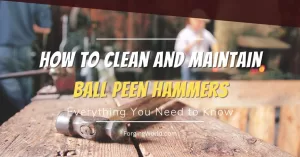Chances are if you mention forging welding to a beginner blacksmith, he or she will be intimidated. Don’t get me wrong, learning to forge welding may not be easy, but it is far from what most people present it to be. One of the biggest mistakes among beginners lies in the use of flux.
Some use it in excess amounts whereas others don’t use it at all. Who is right? As always, the answer is: it depends.
Flux is not always required in forge welding. However, the use of flux increases the chances of making a weld. For beginners, it is usually recommended to use whereas for the experienced it depends. Note that it is generally required to forge weld mild steel to high carbon steel.
Fluxing is by far the most controversial topic in the forge welding world. In the rest of the article you will learn the following:
- The purpose of flux in forge welding
- Is it possible to forge weld without flux?
- Fluxing in gas forge
- What is the best flux?
- How to properly apply flux
As you can see, we have a lot to cover so let’s jump straight in.
What Does Flux Do in Forge Welding?
It makes no sense to further speak about the use of flux if we don’t understand what is its purpose. In order to know whether you should or should not use it, you have to understand its role, pros, and cons. While I could literally write a small book on this topic, here is the summarized answer:
The primary role of flux is to reduce the temperature at which scale and other impurities become fluid on the surface of the material. It also protects the metal’s surface from erosion, allowing you to get clean metal. In general, the flux increases the possibility of making a good weld.
Flux has been used for a long period and still is very popular. However, keep you have to keep in mind that just because you put flux you didn’t have to clean your metal. That is far from the truth. Remember this, it doesn’t matter how much flux you put in if you didn’t clean your material. You won’t get a weld.
The scale is one of the biggest enemies of a successful weld. It refers to the thin texture that appears on the outer surface of the metal. The scale is a by-product of forged metal which occurs as the surface oxidizes during the forging. Unlike rust, it forms on all forged iron and steel. While the scale is not in itself harmful to the metal, the problem starts when it breaks.
Once it breaks and moistures goes through, the scale greatly increases the forming of corrosion at the breakage point. Note that if you are getting scale before you get the material hot enough to flux you should be worried. If you are using the coal forge, lace your workpiece on the top of the fire for a few minutes to start warming.
After that, you should be able to flux. Just make sure you don’t place the billet close to the tuyere. Otherwise, you will get too much air on the material and it will also scale a lot.
How to Properly Use Borax for Forge Welding?
Unfortunately, so many people don’t know how to use borax. It makes me sick when I see people just pouring and pouring borax without any limits. Contrary, others barely put borax on the weld.
You need just enough borax to cover the welding surface. Use a teaspoon to slowly sprinkle it on the metal. A glassy coating on the metal surface is a good indicator that you put enough borax. Using too much flux typically prevents the weld from sticking.
You can get borax on Amazon by following this link.
With borax, you will notice bubbling as you sprinkle it on. This is completely normal, so don’t freak out. The bubbling is just the water in borax molecules. Check the video below to see how too much flux looks on the metal.
Can You Forge Weld Without Flux?
As I have already said before, flux is not a strict requirement but it makes the forge welding process much easier. This is especially the case with beginners. If you are having your first forge welding session, I strongly recommend using flux.
Even if you mess something up along the way, flux can help you to get away with that. However, it is important to know that flux is not glue. Another huge factor that determines the use of the flux is the material choice.
You can forge weld without flux if forge welding wrought iron or mild steel. On the other side, you do need to use flux when forge-welding different materials, such as mild steel to high carbon steel. Keep in mind that master blacksmiths can often get away without using flux.
Knowing all that, the use of flux depends on which material you plan to use. Without flux, you increase the chances of forming oxidation layers. At best, it will cause your weld to be very weak. At worst, you won’t even get a weld. Note that when you heat the material to a red color, most of that bad layer is removed. The problem starts when you take it out and expose it to air. That is where flux comes in.
If you are a beginner blacksmith, know that the window between the “ideal for welding” and “burned another workpiece” is incredibly narrow. As soon as you take out the metal from the forge, you have to weld it. This is how the process of forge welding looks like most of the time:
Heat → Pull → Strike a couple of times → Brush → Flux → Heat → Repeat as necessary
Just be careful not to strike too hard otherwise you will ruing the weld. The strikes should be light but more frequent. However, you will make mistake. Embrace it, this is a learning process.
Is Flux Necessary In the Gas Forge?
With the usage of gas forge becoming more and more popular, we have to cover that. You may hear from older smiths that propane forges cannot be used for forge welding because they can’t reach such high temperatures. Know that early gas forges were primarily designed for farriers which didn’t require welding temperatures. Since then, these types of forges got a bad reputation for forge welding.
The use of flux in the gas forge is strongly recommended due to the increased oxidation. Even if you did everything right, there are still chances of rust forming on the surface. Using flux would drastically decrease these chances.
We could also say that in theory, yes, you can forge weld without flux in a gas forge. In practice, however, not really, especially if you are just getting started.
What Is the Best Flux for Forge Welding?
Ok, now we know that the flux is well-established in forge welding. The next logical question is – What should I use for flux? You would be actually surprised by the list of possible flux choices, however, most of them would not be practical. I will rather stick to the most popular choice option.
Borax is by far the most popular flux in forge welding. It is used over 90% percent of the time among beginner and master smiths. Borax is cheap, readily available, and very easy to use. It can also be mixed with other additives to produce a superior effect.
Borax is an alkaline salt with a white powdery look which is most popular as a laundry washing powder. Note that the term “borax” is often used for some similar compounds. There is a difference between boric acid and borax. Boric acid is formed after acidifying boran whereas borax is the natural component mined from the ground.
One more thing you have to understand here. There is a huge difference between anhydrous borax and dehydrated borax. In borax, water is present in two major forms: moisture between the borax particles and water which is trapped in the borax crystals, also known as crystal water. Both of them cause bubbling which turns to steam. This makes the process of borax flowing out on the surface much harder.
In regards to the moisture between particles, just think about sand. Namely, if sand is completely dry, it barely has a footprint. Now, if the sand is a little damp, you can easily write your name with your finger. If it is extremely damp, you can make a ball out of it and throw it on someone. On the other side, if it is too wet, it acts like mud. Just like sand, borax will stick together if there is too much water between particles.
However, if the borax flows freely, the particles are so dry it becomes dehydrated. Keep in mind that baking it in the oven might dry out the surface particles but it will reabsorb moisture until it reaches equilibrium with the surroundings.



